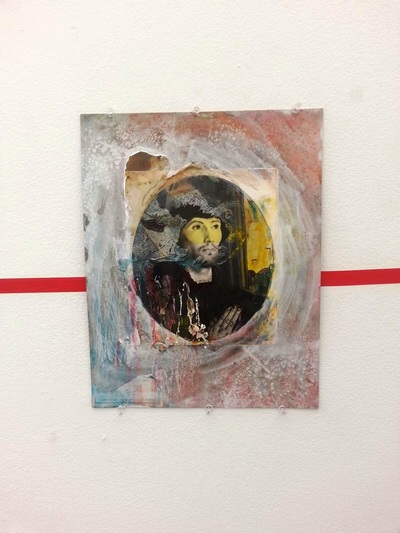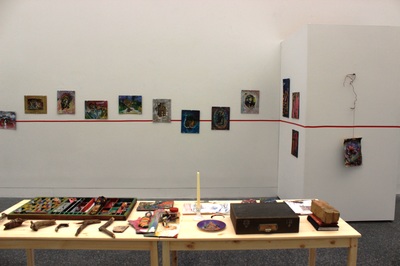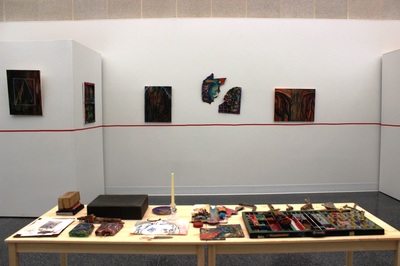INSTALLATION
2015
PARADOXICAL TIME FIELD- AT HOME WITH THE ORDINARY & THE EXTRAORDINARY
MAY 2015 - SEPTEMBER 2015
Cedar Crest College
Center for Visual Research
Allentown, PA
Cedar Crest College
Center for Visual Research
Allentown, PA
ARTIST STATEMENT:
My intention is to create an experience that generates thoughts and questions about boundaries or lines in space. Through my collection of collage work, I was given the opportunity to deconstruct, reconstruct, and explore the previous artist’s replicated images where elements of boundaries were investigated. Boundaries were redefined by further application of mediums to change the surface as they will through spraying water, pouring paint, coffee or wine , scratching at the surface, etc. The need to render them into my own investigation and understanding of boundaries and the paradox that often exists with beliefs and ideas through dismantling and the collage process that defines and defies the borders of boundaries within ourselves, others and the everyday boundaries we may encounter.
Furthermore, the canvas paintings were created in watered down painted layers to find out what is deeper at the surface. Water is sprayed down to create layers of acrylic paint on top of canvas, there beneath the dripping paint emerges abstract shapes of peak, valleys, mountains, rivers and streams where they are later refined and defined. Bodily landscapes internally and externally, reflecting one another as the moon is reflected in a body of water so is the soul reflected by the environment in which it thrives and lives. Rivers going downward, mountain ranges in direction upward, spiritual plane and landscapes of the soul arising in imagery, the horizon of their boundless borders within atmospheric space. Like the European Symbolist Landscape painters it is about the mood of the abstracted conscious, subconscious and unconscious and “an attempt to a unique inner vision that could not be mass produced” is archetypal of the symbolist thought and creation (Van Gogh to Kadinksy, 2012). Most of all, there hanging on the walls of the gallery with roughed up collage work and the landscape-like paintings lays the paradox, two existing in the space as one, one not without the other.
As a 5 year old child I stole my mother’s red lipstick and drew a red line through the center of my entire bedroom wall, my mother tried to wash it off but it had stained the white wall. The significance of this red line in the space is that it holds power that defines these boundaries where exploration can be sought. The negative space around the line symbolizes the nothingness and everythingness above and below—it is the all encompassing white. Where the red line envelopes oneself and where one enters the space and becomes part of it—as in music—is where there are no boundaries. The viewer becomes part of it; it has a beginning and ending only while listening to it, but a memory is formed—the experience is eternal and boundary-less. For example, symphonies of mood as one would experience in a symphony hall, where the audience and the music are one is experienced as T.S. Eliot wrote in Dry Salvages, Poem V:
For most of us, there is only the unattended
Moment, the moment in and out of time,
The distraction fit, lost in a shaft of sunlight,
The wild thyme unseen, or the winter lightning
Or the waterfall, or music heard so deeply
That it is not heard at all, but you are the music
While the music lasts. These are only hints and guesses,
Hints followed by guesses; and the rest
Is prayer, observance, discipline, thought and action.
The hint half guessed, the gift half understood, is Incarnation.
As it reads, “you are the music while the music lasts…” in relation to the space where there are set boundaries and in other areas none at all, you become part of the placement as being present in it.
In the center of the space stands a large table. Resting on the table is a horizontally positioned assemblage drawer, sketchbook pages, and junk-pile pieces of notebook writings. Various miscellaneous items include tools, recent drawings and writings, findings from the forest, and the “childhood thinking” of a broken branch in the shape of an Indian axe. All is out on the table inviting the viewer to touch. The viewer may pick them up, read through, play, turn-over and interact because all at the table is the choosing of the viewer to do with the objects as one pleases. In essence, the table is a space where boundaries can be investigated. All is open for discovery into a space that was once a private boundary and is no longer mine (the artist), but is now drawn into the viewer’s private world and is to be investigated by their choice at the moment. The discovery is at the hands of the explorer as they take what they want from the space in a Paradoxical Time Field. On the table are remnants—fractured pieces of the self that make up the whole of that, when set at a table, complete the self, holy or wholly to be shared or respected in its quiet and personal space, depending on what the viewer wants from the experience at hand.
In conclusion, my objective of this show is to create boundaries in a space and what they look like, in addition our relationships to the paradox that exists within placements and boundaries internally and externally within us. As the artist, I invite and hope for further exploration of systems of personal boundaries, rules of self, art, and individual relationship to boundaries. Through the artwork, arranged on the wall among the red boundary line, is where the ideas of comfort and uniformity can be broken and redefined. It was my wish to bring this experience to Cedar Crest College, Center for Visual Research.
Reference:
ART OF EUROPE. (1941, January 1). Retrieved February 1, 2015, from http://www.artofeurope.com/eliot/eli4.htm
Van Gogh to Kandinsky: Symbolist Landscape in Europe 1880-1910, National Gallery of Scotland, http://www.aworldtowin.net/reviews/SymbolistLandscape.html until 14 October 2012, ticket £10; £7 concessions.
My intention is to create an experience that generates thoughts and questions about boundaries or lines in space. Through my collection of collage work, I was given the opportunity to deconstruct, reconstruct, and explore the previous artist’s replicated images where elements of boundaries were investigated. Boundaries were redefined by further application of mediums to change the surface as they will through spraying water, pouring paint, coffee or wine , scratching at the surface, etc. The need to render them into my own investigation and understanding of boundaries and the paradox that often exists with beliefs and ideas through dismantling and the collage process that defines and defies the borders of boundaries within ourselves, others and the everyday boundaries we may encounter.
Furthermore, the canvas paintings were created in watered down painted layers to find out what is deeper at the surface. Water is sprayed down to create layers of acrylic paint on top of canvas, there beneath the dripping paint emerges abstract shapes of peak, valleys, mountains, rivers and streams where they are later refined and defined. Bodily landscapes internally and externally, reflecting one another as the moon is reflected in a body of water so is the soul reflected by the environment in which it thrives and lives. Rivers going downward, mountain ranges in direction upward, spiritual plane and landscapes of the soul arising in imagery, the horizon of their boundless borders within atmospheric space. Like the European Symbolist Landscape painters it is about the mood of the abstracted conscious, subconscious and unconscious and “an attempt to a unique inner vision that could not be mass produced” is archetypal of the symbolist thought and creation (Van Gogh to Kadinksy, 2012). Most of all, there hanging on the walls of the gallery with roughed up collage work and the landscape-like paintings lays the paradox, two existing in the space as one, one not without the other.
As a 5 year old child I stole my mother’s red lipstick and drew a red line through the center of my entire bedroom wall, my mother tried to wash it off but it had stained the white wall. The significance of this red line in the space is that it holds power that defines these boundaries where exploration can be sought. The negative space around the line symbolizes the nothingness and everythingness above and below—it is the all encompassing white. Where the red line envelopes oneself and where one enters the space and becomes part of it—as in music—is where there are no boundaries. The viewer becomes part of it; it has a beginning and ending only while listening to it, but a memory is formed—the experience is eternal and boundary-less. For example, symphonies of mood as one would experience in a symphony hall, where the audience and the music are one is experienced as T.S. Eliot wrote in Dry Salvages, Poem V:
For most of us, there is only the unattended
Moment, the moment in and out of time,
The distraction fit, lost in a shaft of sunlight,
The wild thyme unseen, or the winter lightning
Or the waterfall, or music heard so deeply
That it is not heard at all, but you are the music
While the music lasts. These are only hints and guesses,
Hints followed by guesses; and the rest
Is prayer, observance, discipline, thought and action.
The hint half guessed, the gift half understood, is Incarnation.
As it reads, “you are the music while the music lasts…” in relation to the space where there are set boundaries and in other areas none at all, you become part of the placement as being present in it.
In the center of the space stands a large table. Resting on the table is a horizontally positioned assemblage drawer, sketchbook pages, and junk-pile pieces of notebook writings. Various miscellaneous items include tools, recent drawings and writings, findings from the forest, and the “childhood thinking” of a broken branch in the shape of an Indian axe. All is out on the table inviting the viewer to touch. The viewer may pick them up, read through, play, turn-over and interact because all at the table is the choosing of the viewer to do with the objects as one pleases. In essence, the table is a space where boundaries can be investigated. All is open for discovery into a space that was once a private boundary and is no longer mine (the artist), but is now drawn into the viewer’s private world and is to be investigated by their choice at the moment. The discovery is at the hands of the explorer as they take what they want from the space in a Paradoxical Time Field. On the table are remnants—fractured pieces of the self that make up the whole of that, when set at a table, complete the self, holy or wholly to be shared or respected in its quiet and personal space, depending on what the viewer wants from the experience at hand.
In conclusion, my objective of this show is to create boundaries in a space and what they look like, in addition our relationships to the paradox that exists within placements and boundaries internally and externally within us. As the artist, I invite and hope for further exploration of systems of personal boundaries, rules of self, art, and individual relationship to boundaries. Through the artwork, arranged on the wall among the red boundary line, is where the ideas of comfort and uniformity can be broken and redefined. It was my wish to bring this experience to Cedar Crest College, Center for Visual Research.
Reference:
ART OF EUROPE. (1941, January 1). Retrieved February 1, 2015, from http://www.artofeurope.com/eliot/eli4.htm
Van Gogh to Kandinsky: Symbolist Landscape in Europe 1880-1910, National Gallery of Scotland, http://www.aworldtowin.net/reviews/SymbolistLandscape.html until 14 October 2012, ticket £10; £7 concessions.























